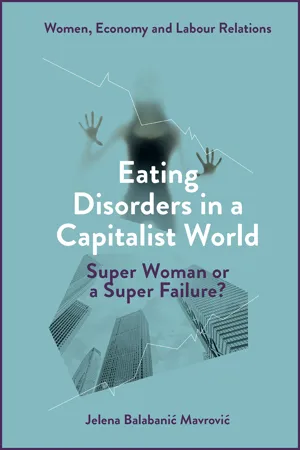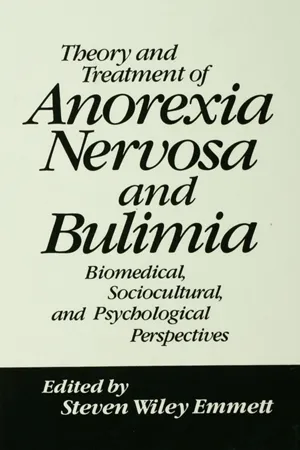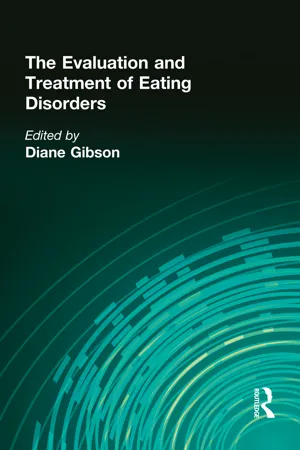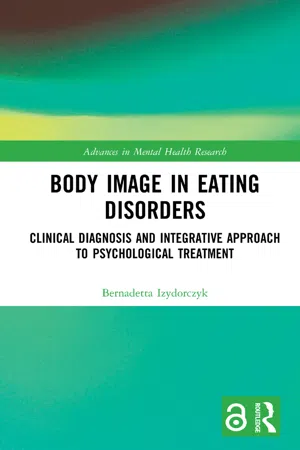Psychology
Social Learning Theory Anorexia
Social Learning Theory of Anorexia posits that individuals learn disordered eating behaviors through observation, imitation, and reinforcement within their social environment. This theory suggests that societal pressures, media influence, and family dynamics play a significant role in the development and maintenance of anorexia nervosa. It emphasizes the impact of social interactions and cultural factors on the development of eating disorders.
Written by Perlego with AI-assistance
Related key terms
4 Key excerpts on "Social Learning Theory Anorexia"
- eBook - ePub
Eating Disorders in a Capitalist World
Super Woman or a Super Failure?
- Jelena Balabanić Mavrović(Author)
- 2023(Publication Date)
- Emerald Publishing Limited(Publisher)
Chapter 4 Socio-Cultural Theories of the Development of Eating Disorders (Anorexia and Bulimia) Modern theories on eating disorders cannot exclude the influence of the environment on the formation of attitudes about one's body. Society, the media, one's peers and parents directly and indirectly influence how we see ourselves. The most famous models of socio-cultural theories of eating disorders are: the Tripartite Model (Thompson et al., 1999), the Dual Pathway Model (Stice, 1996) and Objectification Theory (Fredrickson & Roberts, 1997). We shall briefly discuss them below. The Tripartite Model was developed by Thompson and his colleagues in an effort to establish what external factors influence body image dissatisfaction and disordered eating. Thompson et al. (1999) proved that the pressure to be thin coming from peers, parents and the media can create a negative body image. Comments and teasing by peers and parents about body weight, appearance, clothing or eating can contribute to the internalisation of a thin appearance as a desirable ideal in a young individual and encourage comparison with images from the media or with their peers, which is regularly detrimental to the young individual. The psychological functioning of young people is thus not only impaired by bulimic symptoms, but also with the development of depression, anxiety or low self-esteem (Thompson et al., 1999). Another approach to studying the influence of the environment on the development of disordered eating is Stice's Dual Pathway Model (1994). Built on an earlier socio-cultural model (Striegel-Moore et al., 1986), it takes into account various messages coming from peers, the family, and the media which propagate the thin ideal (Ferguson, 2013), the importance of good looks for women, and the importance of looks for social success (Stice, 1994, 2001) - eBook - ePub
Theory and Treatment of Anorexia Nervosa and Bulimia
Biomedical Sociocultural & Psychological Perspectives
- Steven Wiley Emmett, Steven Wiley Emmett(Authors)
- 2013(Publication Date)
- Routledge(Publisher)
Part IISociocultural PerspectivePassage contains an image
Chapter 5 Anorexia Nervosa and Bulimia: The Sociocultural Context
Donald M. Schwartz Michael G. Thompson and Craig L. JohnsonDOI: 10.4324/9780203776193-7Our society’s longstanding preoccupation with sex and sexual matters is being challenged by a new cultural obsession: The relentless pursuit of thinness. Ours is an age fixated on food and bodies. A 1978 Nielson survey showed that 45% of all U.S. households have somebody dieting during the course of the year. Fifty-six percent of all women 24–54 years of age diet. And of women who diet, 76% acknowledge doing so for cosmetic rather than health reasons. Concerns about diet and exercise have shifted from a growing leisure time hobby to a national obsession. We believe that one effect of this change, and other changes in our culture, has been an increase in women suffering from eating disorders. This includes an increase in the incidence of anorexia nervosa, as well as the more newly identified problems of relatively normal weight women who binge eat and then employ extreme forms of weight control, including vomiting and laxative abuse.The potential effects of an increase in eating disorders is reason for concern. The destructive impact on individuals of these disorders continues to be documented by those who research and treat them. Recent trends suggest that more and more young women, and perhaps young men, will be afflicted by these problems. This chapter is based on the assertion that the apparent increase in anorexia nervosa and related eating disorders is the result of forces at work in the culture which direct girls and women in distress toward this particular solution. The anthropologist, Clyde Kluckholn (1984), wrote: “Every culture has its pet mental disturbances.” We are worried that eating disorders are becoming the pet mental disturbance of affluent cultures in general and America in particular. Especially at risk are certain vulnerable groups of adolescent girls and young adult women. - eBook - ePub
- Diane Gibson(Author)
- 2014(Publication Date)
- Routledge(Publisher)
6 To be effective, the contract should be specific to the needs of the patient. The contract makes clear that the patient herself is responsible for change and that her success will often depend on her degree of motivation. A contract also reminds the therapist of the importance of initial and continuing assessment.A number of authors have described the use of social skills training with this client population. The psychodynamic model of Bruch7 , 8 and others sees the anorexic individual as feeling overwhelmed and smothered by others. One of the most consistent findings from follow up studies on anorexia nervosa are the social anxiety and isolation of patients. However, despite the apparent theoretical justification for SST with these patients, little research has actually been done into its efficacy, Most studies are limited to the single case study design which, though valid in itself, cannot substitute for controlled trials.9 , 10 The only controlled trial known to the present authors is that by Pillay and Crisp11 into the impact of SST with an established in-patient treatment program for anorexia nervosa. Unfortunately this study is so beset by methodological problems that it is impossible to draw any firm conclusions from it. In the view of the present authors SST and art therapy are currently justified on theoretical and practical grounds, though clearly research is needed in this area.Body image distortion is a major area of discussion in the literature. Results of studies evaluating the perceptual component of the body image of patients with anorexia nervosa have been inconsistent. Fries12 found that body perception indices significantly differentiated his anorexic subjects from controls, a finding which agreed with the previous results of Slade and Russell.13 However, since several controls overestimated their size by 21% to 33% Fries was not convinced that overestimation was specific to anorexia nervosa. Button et al.,14 found no significant differences between anorexic subjects and controls, both of whom overestimated body size. Marked overestimation by anorexics was however associated with an early relapse. In contrast to the Button study, results by Wingate and Christie15 - eBook - ePub
Body Image in Eating Disorders
Clinical Diagnosis and Integrative Approach to Psychological Treatment
- Bernadetta Izydorczyk(Author)
- 2021(Publication Date)
- Routledge(Publisher)
Anorexia nervosa literally means “lack of appetite” for psychological reasons. However, this name does not reflect the true nature of this disorder, and even contradicts it. The anorexic person has a great need for food, and this is his chief concern. Giving in to one’s own needs causes panic, fear, and dread so great that it takes the form of a food phobia, an obsession with not eating/eating. Instead of eating food, the anorexic patients realize this need by fantasizing about eating or feeding others. Sometimes, they succumb to this need by eating a large amount of food in a short time (binging), and then purging in various ways. Weight loss is experienced as a success, it becomes proof of competence, strength, and endurance, while gaining weight becomes a failure, shame, and loss of self-control. Therefore, patients with anorexia have no choice but to deny that anything harmful is happening to them because, paradoxically, the disorder may make them feel valuable. One could say that up to a certain point, the patients experience more “benefits” (described above) than health costs. In the face of losses, they sometimes remain uncritical. Only the breakdown of social and family life, the loss of social position at school, or the feeling that the disease takes up 90%–100% of thoughts and life activities, leaving no room for anything else, leads the patients to start treatment and look for a different, nondestructive way to gain the feeling of being complete, independent, and competent. Otherwise, the life of an anorexic patient focuses on eating at the expense of every other sphere (relationships, family, own interests, school, work), leading to mental deterioration (cognitive problems, depression, insomnia, suicidal thoughts), physical exhaustion, and, in extreme cases, death.As can be seen, it appears that in these emotionally difficult situations, food has a symbolic function for adolescents, being an expression of unmet needs and a failure to cope with cultural pressures concerning beauty.Attachment patterns and body image
As indicated by Bowlby’s attachment theory (1988), Fonagy’s mentalization theory, and object relations theory (especially Mahler’s separation–individuation theory), the development of the experience of corporeality is influenced by patterns of early childhood attachment to their caregiver (Schier, 2020 ). The attachment pattern becomes an important factor explaining the so-called safe and unsafe (emotionally unstable) ways of establishing relations between the child’s body and the caregiver’s body. It determines the way of establishing social relations in adulthood (Bowlby, 2021 ). The trusting (secure) attachment pattern provides the basis for the development of the correct proportion of closeness (emotional as well as bodily) between the child and its caregiver (Schier, 2020). People who have experienced insecure relationship patterns in the course of their childhood development and their relationship with the caregiver may also develop a maladaptive (insecure) relationship with their own body. Schier (2020) introduced the term “loneliness of the body.” It refers to the bodily experience of children and adolescents as a state of disruption of trust in the early childhood relationship with the caregiver. A child whose body was loved, accepted, and cared for will love, accept, and care for their body later in life (Kearney-Cooke, 2002 ; Patton et al., 2014
Index pages curate the most relevant extracts from our library of academic textbooks. They’ve been created using an in-house natural language model (NLM), each adding context and meaning to key research topics.



